英语句子成分及基本句型..
- 格式:ppt
- 大小:1.09 MB
- 文档页数:60
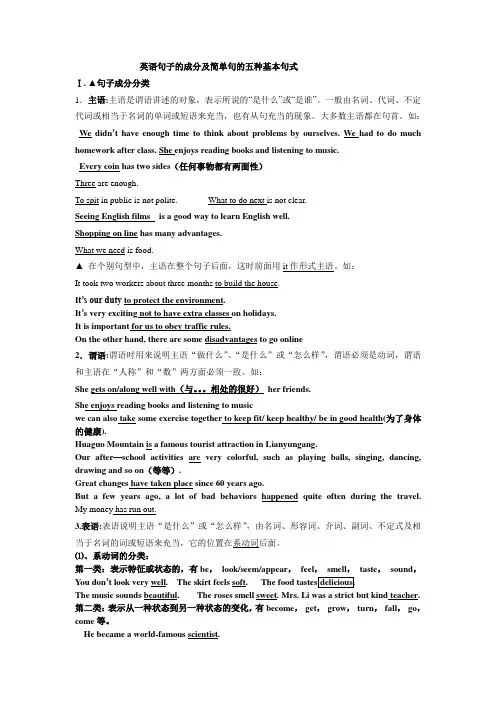
英语句子的成分及简单句的五种基本句式Ⅰ. ▲句子成分分类1.主语:主语是谓语讲述的对象,表示所说的“是什么”或“是谁”。
一般由名词、代词、不定代词或相当于名词的单词或短语来充当,也有从句充当的现象。
大多数主语都在句首。
如:We didn’t have enough time to think about problems by ourselves. We had to do muchhomework after class. She enjoys reading books and listening to music.Every coin has two sides(任何事物都有两面性)Three are enough.To spit in public is not polite. What to do next is not clear.Seeing English films is a good way to learn English well.Shopping on line has many advantages.What we need is food.▲在个别句型中,主语在整个句子后面,这时前面用it作形式主语。
如:It took two workers about three months to build the house.I t’s our duty to protect the environment.It’s very exciting not to have extra classes on holidays.It is important for us to obey traffic rules.On the other hand, there are some disadvantages to go online2.谓语:谓语时用来说明主语“做什么”、“是什么”或“怎么样”,谓语必须是动词,谓语和主语在“人称”和“数”两方面必须一致。
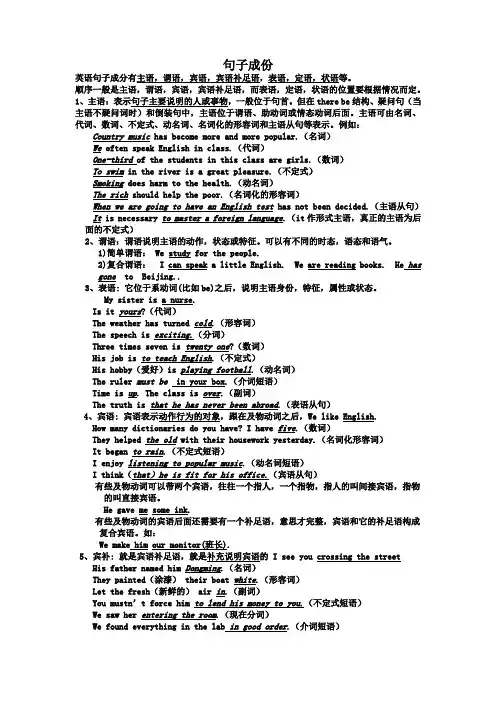
句子成份英语句子成分有主语,谓语,宾语,宾语补足语,表语,定语,状语等。
顺序一般是主语,谓语,宾语,宾语补足语,而表语,定语,状语的位置要根据情况而定。
1、主语:表示句子主要说明的人或事物,一般位于句首。
但在there be结构、疑问句(当主语不疑问词时)和倒装句中,主语位于谓语、助动词或情态动词后面。
主语可由名词、代词、数词、不定式、动名词、名词化的形容词和主语从句等表示。
例如:Country music has become more and more popular.(名词)We often speak English in class.(代词)One-third of the students in this class are girls.(数词)To swim in the river is a great pleasure.(不定式)Smoking does harm to the health.(动名词)The rich should help the poor.(名词化的形容词)When we are going to have an English test has not been decided.(主语从句)It is necessary to master a foreign language.(it作形式主语,真正的主语为后面的不定式)2、谓语:谓语说明主语的动作,状态或特征。
可以有不同的时态,语态和语气。
1)简单谓语: We study for the people.2)复合谓语: I can speak a little English. We are reading books. He hasgone to Beijing..3、表语: 它位于系动词(比如be)之后,说明主语身份,特征,属性或状态。
My sister is a nurse.Is it yours?(代词)The weather has turned cold.(形容词)The speech is exciting.(分词)Three times seven is twenty one?(数词)His job is to teach English.(不定式)His hobby(爱好)is playing football.(动名词)The ruler must be in your box.(介词短语)Time is up. The class is over.(副词)The truth is that he has never been abroad.(表语从句)4、宾语: 宾语表示动作行为的对象,跟在及物动词之后,We like English.How many dictionaries do you have? I have five.(数词)They helped the old with their housework yesterday.(名词化形容词)It began to rain.(不定式短语)I enjoy listening to popular music.(动名词短语)I think(that)he is fit for his office.(宾语从句)有些及物动词可以带两个宾语,往往一个指人,一个指物,指人的叫间接宾语,指物的叫直接宾语。

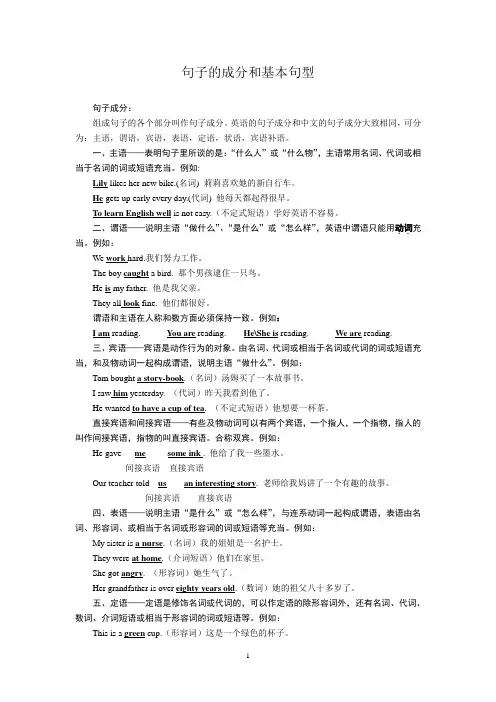
句子的成分和基本句型句子成分:组成句子的各个部分叫作句子成分。
英语的句子成分和中文的句子成分大致相同,可分为:主语,谓语,宾语,表语,定语,状语,宾语补语。
一、主语——表明句子里所谈的是:“什么人”或“什么物”,主语常用名词、代词或相当于名词的词或短语充当。
例如:Lily likes her new bike.(名词) 莉莉喜欢她的新自行车。
He gets up early every day.(代词) 他每天都起得很早。
To learn English well is not easy.(不定式短语)学好英语不容易。
二、谓语——说明主语“做什么”、“是什么”或“怎么样”,英语中谓语只能用动词..充当。
例如:We work hard.我们努力工作。
The boy caught a bird. 那个男孩逮住一只鸟。
He is my father. 他是我父亲。
They all look fine. 他们都很好。
谓语和主语在人称和数方面必须保持一致。
例如:I am reading. You are reading. He\She is reading. We are reading.三、宾语——宾语是动作行为的对象。
由名词、代词或相当于名词或代词的词或短语充当,和及物动词一起构成谓语,说明主语“做什么”。
例如:Tom bought a story-book.(名词)汤姆买了一本故事书。
I saw him yesterday. (代词)昨天我看到他了。
He wanted to have a cup of tea. (不定式短语)他想要一杯茶。
直接宾语和间接宾语——有些及物动词可以有两个宾语,一个指人,一个指物,指人的叫作间接宾语,指物的叫直接宾语。
合称双宾。
例如:He gave me some ink . 他给了我一些墨水。
间接宾语直接宾语Our teacher told us an interesting story. 老师给我妈讲了一个有趣的故事。
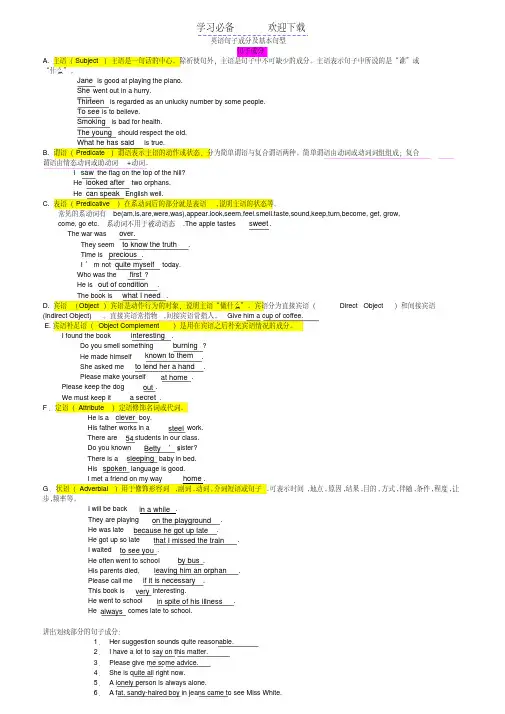
英语句子成分及基本句型句子成分A. 主语(Subject)主语是一句话的中心。
除祈使句外,主语是句子中不可缺少的成分。
主语表示句子中所说的是“谁”或“什么”。
Jane is good at playing the piano.She went out in a hurry.Thirteen is regarded as an unlucky number by some people.To see is to believe.Smoking is bad for health.The young should respect the old.What he has said is true.B. 谓语(Predicate)谓语表示主语的动作或状态,分为简单谓语与复合谓语两种。
简单谓语由动词或动词词组组成;复合谓语由情态动词或助动词+动词。
I saw the flag on the top of the hill?He looked after two orphans.He can speak English well.C. 表语(Predicative)在系动词后的部分就是表语,说明主语的状态等。
常见的系动词有be(am,is,are,were,was),appear,look,seem,feel,smell,taste,sound,keep,turn,become, get, grow,come, go etc.系动词不用于被动语态.The apple tastes sweet.The war was over.They seem to know the truth.Time is precious.I’m not quite myself today.Who was the first?He is out of condition.The book is what I need.D. 宾语(Object)宾语是动作行为的对象,说明主语“做什么”。
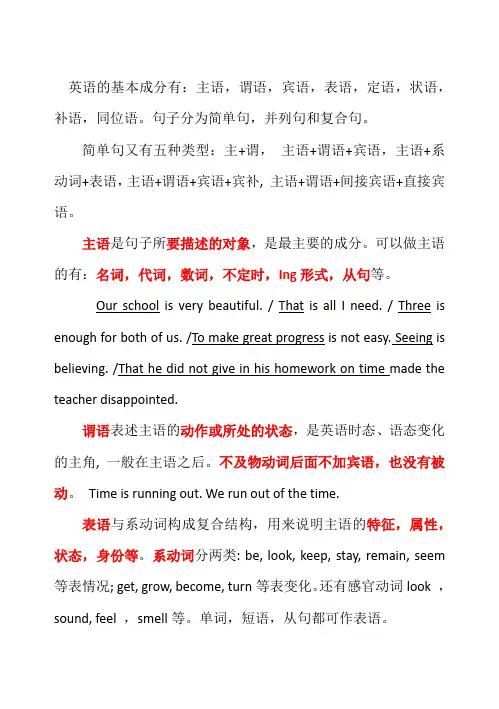
英语的基本成分有:主语,谓语,宾语,表语,定语,状语,补语,同位语。
句子分为简单句,并列句和复合句。
简单句又有五种类型:主+谓,主语+谓语+宾语,主语+系动词+表语,主语+谓语+宾语+宾补, 主语+谓语+间接宾语+直接宾语。
主语是句子所要描述的对象,是最主要的成分。
可以做主语的有:名词,代词,数词,不定时,Ing形式,从句等。
Our school is very beautiful. / That is all I need. / Three is enough for both of us. /To make great progress is not easy. Seeing is believing. /That he did not give in his homework on time made the teacher disappointed.谓语表述主语的动作或所处的状态,是英语时态、语态变化的主角, 一般在主语之后。
不及物动词后面不加宾语,也没有被动。
Time is running out. We run out of the time.表语与系动词构成复合结构,用来说明主语的特征,属性,状态,身份等。
系动词分两类: be, look, keep, stay, remain, seem 等表情况; get, grow, become, turn等表变化。
还有感官动词look ,sound, feel ,smell等。
单词,短语,从句都可作表语。
The world is a book. (名词做表语)You are many, but they are few. 代词she was the first to arrive but the last to leave. 数词Please feel free to say what you really think. 形容词My wish is to be a good teacher. 不定式.Is anybody in ? 副词宾语分为直接宾语和间接宾语,直接宾语是动作的承受者或结果,Who know the answer? / I need help. 间接宾语表示动作是对谁做或为谁做的。
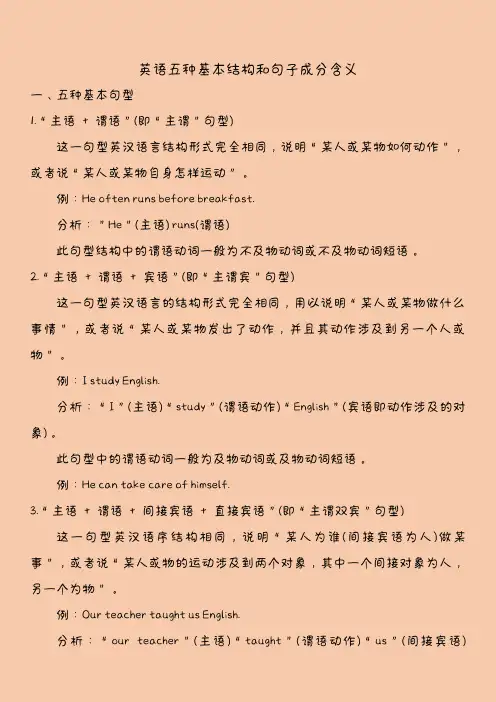
英语五种基本结构和句子成分含义一、五种基本句型1.“主语+ 谓语”(即“主谓”句型)这一句型英汉语言结构形式完全相同,说明“某人或某物如何动作”,或者说“某人或某物自身怎样运动”。
例:He often runs before breakfast.分析:”He”(主语) runs(谓语)此句型结构中的谓语动词一般为不及物动词或不及物动词短语。
2.“主语+ 谓语+ 宾语”(即“主谓宾”句型)这一句型英汉语言的结构形式完全相同,用以说明“某人或某物做什么事情”,或者说“某人或某物发出了动作,并且其动作涉及到另一个人或物”。
例:I study English.分析:“I”(主语)“study”(谓语动作)“English”(宾语即动作涉及的对象)。
此句型中的谓语动词一般为及物动词或及物动词短语。
例:He can take care of himself.3.“主语+ 谓语+ 间接宾语+ 直接宾语”(即“主谓双宾”句型)这一句型英汉语序结构相同,说明“某人为谁(间接宾语为人)做某事”,或者说“某人或物的运动涉及到两个对象,其中一个间接对象为人,另一个为物”。
例:Our teacher taught us English.分析:“our teacher”(主语)“taught”(谓语动作)“us”(间接宾语)“English”(直接宾语)。
4.“主语+ 谓语+ 宾语+ 宾语补足语”(即“主谓宾宾补”句型)这一句型说明“某人或某物要求(使、让)某人做什么”或“某人感觉某人或物怎么样”。
例:Our teacher asks us to write a short story..分析:“our teacher”(主语)“asks”(谓语动作)“us”(宾语即动作涉及的对象)“to write a short story”(补语--补充说明宾语做什么)。
5.“主语+ 系动词+ 表语”(即“主系表”句型)这一句型用以说明“某人(某物、某事、某种概念)具有什么特征或处于什么状态”。
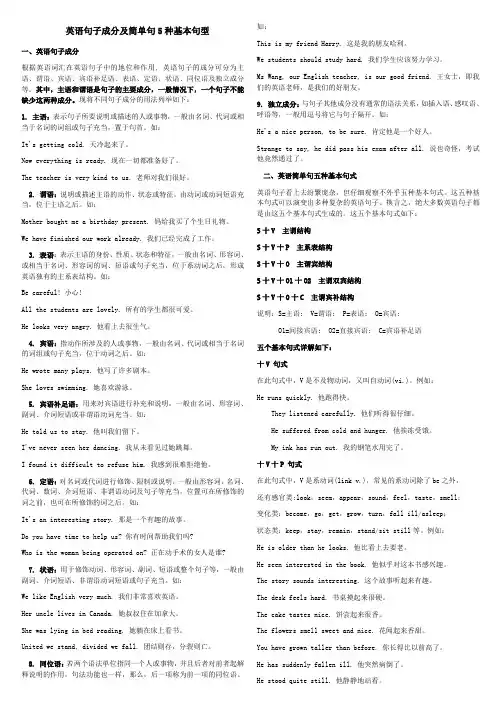
英语句子成分及简单句5种基本句型一、英语句子成分根据英语词汇在英语句子中的地位和作用, 英语句子的成分可分为主语、谓语、宾语、宾语补足语、表语、定语、状语、同位语及独立成分等。
其中,主语和谓语是句子的主要成分,一般情况下,一个句子不能缺少这两种成分。
现将不同句子成分的用法列举如下:1. 主语:表示句子所要说明或描述的人或事物,一般由名词、代词或相当于名词的词组或句子充当,置于句首。
如:It's getting cold. 天冷起来了。
Now everything is ready. 现在一切都准备好了。
The teacher is very kind to us. 老师对我们很好。
2. 谓语:说明或描述主语的动作、状态或特征,由动词或动词短语充当,位于主语之后。
如:Mother bought me a birthday present. 妈给我买了个生日礼物。
We have finished our work already. 我们已经完成了工作。
3. 表语:表示主语的身份、性质、状态和特征,一般由名词、形容词、或相当于名词、形容词的词、短语或句子充当,位于系动词之后,形成英语独有的主系表结构。
如:Be careful! 小心!All the students are lovely. 所有的学生都很可爱。
He looks very angry. 他看上去很生气。
4. 宾语:指动作所涉及的人或事物,一般由名词、代词或相当于名词的词组或句子充当,位于动词之后。
如:He wrote many plays. 他写了许多剧本。
She loves swimming. 她喜欢游泳。
5. 宾语补足语:用来对宾语进行补充和说明,一般由名词、形容词、副词、介词短语或非谓语动词充当。
如:He told us to stay. 他叫我们留下。
I've never seen her dancing. 我从未看见过她跳舞。
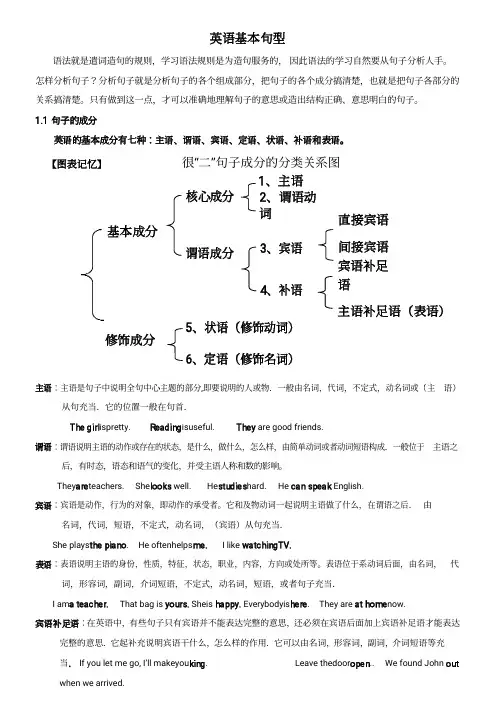
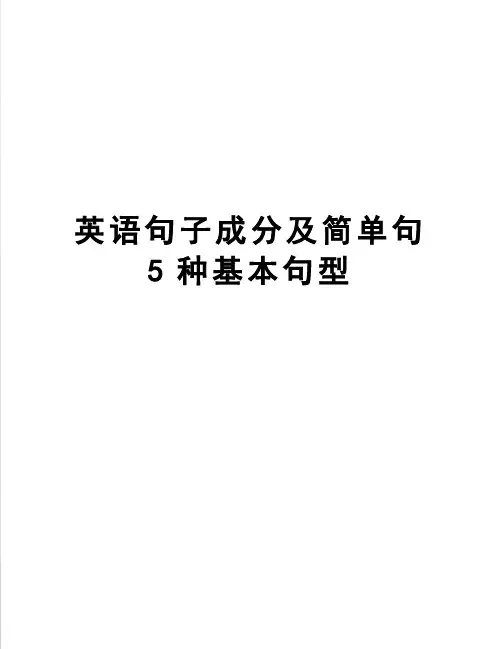
英语句子成分及简单句5种基本句型英语句子成分及简单句5种基本句型一、英语句子成分根据英语词汇在英语句子中的地位和作用, 英语句子的成分可分为主语、谓语、宾语、宾语补足语、表语、定语、状语、同位语及独立成分等。
其中,主语和谓语是句子的主要成分,一般情况下,一个句子不能缺少这两种成分。
现将不同句子成分的用法列举如下:1. 主语:表示句子所要说明或描述的人或事物,一般由名词、代词或相当于名词的词组或句子充当,置于句首。
如:It's getting cold. 天冷起来了。
Now everything is ready. 现在一切都准备好了。
The teacher is very kind to us. 老师对我们很好。
2. 谓语:说明或描述主语的动作、状态或特征,由动词或动词短语充当,位于主语之后。
如:Mother bought me a birthday present. 妈给我买了个生日礼物。
We have finished our work already. 我们已经完成了工作。
3. 表语:表示主语的身份、性质、状态和特征,一般由名词、形容词、或相当于名词、形容词的词、短语或句子充当,位于系动词之后,形成英语独有的主系表结构。
如:Be careful! 小心!All the students are lovely. 所有的学生都很可爱。
He looks very angry. 他看上去很生气。
4. 宾语:指动作所涉及的人或事物,一般由名词、代词或相当于名词的词组或句子充当,位于动词之后。
如:He wrote many plays. 他写了许多剧本。
She loves swimming. 她喜欢游泳。
5. 宾语补足语:用来对宾语进行补充和说明,一般由名词、形容词、副词、介词短语或非谓语动词充当。
如:He told us to stay. 他叫我们留下。
I've never seen her dancing. 我从未看见过她跳舞。
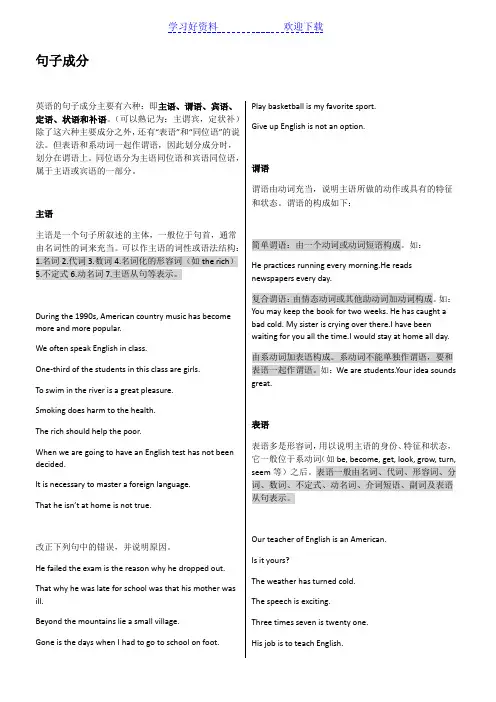
学习好资料欢迎下载句子成分英语的句子成分主要有六种:即主语、谓语、宾语、定语、状语和补语。
(可以熟记为:主谓宾,定状补)除了这六种主要成分之外,还有“表语”和“同位语”的说法。
但表语和系动词一起作谓语,因此划分成分时,划分在谓语上。
同位语分为主语同位语和宾语同位语,属于主语或宾语的一部分。
主语主语是一个句子所叙述的主体,一般位于句首,通常由名词性的词来充当。
可以作主语的词性或语法结构:1.名词2.代词3.数词4.名词化的形容词(如the rich)5.不定式6.动名词7.主语从句等表示。
During the 1990s, American country music has become more and more popular.We often speak English in class.One-third of the students in this class are girls.To swim in the river is a great pleasure.Smoking does harm to the health.The rich should help the poor.When we are going to have an English test has not been decided.It is necessary to master a foreign language.That he isn’t at home is not true.改正下列句中的错误,并说明原因。
He failed the exam is the reason why he dropped out.That why he was late for school was that his mother was ill.Beyond the mountains lie a small village.Gone is the days when I had to go to school on foot.Play basketball is my favorite sport.Give up English is not an option.谓语谓语由动词充当,说明主语所做的动作或具有的特征和状态。
英语句子的基本句型和成分一、五大基本句型1. 主谓(SV):The little girl smiled.S V2. 主谓宾(SVO):Everybody likes it.S V O3. 主谓双宾(SVOO):My father bought me a new computer.S V IO DOMy father bought a new computer for me.S V DO IO4. 主谓宾宾补(SVOC):The old lady keeps her house clean.S V O C5. 主谓补(SVC)(又名主系表):The chilcken tastes great!S V C二、7大句子成分①主语②谓语③宾语④表语⑤宾补⑥定语⑦状语主语(Subject )句子的主体,全句述说的对象。
一般由名词、代词、动词不定式、动名词或从句担任,常至于句首。
如:I love you. The boy needs a pen.【活学活用1】 句子成分例句主语形式主语People put different kinds of food into it. Hot Pot is famous….名词 名词短语 Eating too much meat and seafood is harmful to our health.To see is to believe. Do you like hot pot?It is necessary (for us) to learn English .It took him five hours to fly to Guangzhou .形式主语: ______ 真正主语:__________________谓语(predicate )说明主语的动作和状态。
由动词担任,常至于主语后面。
如:I love you. The boy needs a pen.【活学活用2】宾语(object )表示动词的动作对象。
英语句子成分及简单句5种基本句型一、英语句子成分根据英语词汇在英语句子中的地位和作用, 英语句子的成分可分为主语、谓语、宾语、宾语补足语、表语、定语、状语、同位语及独立成分等。
其中,主语和谓语是句子的主要成分,一般情况下,一个句子不能缺少这两种成分。
现将不同句子成分的用法列举如下:1. 主语:表示句子所要说明或描述的人或事物,一般由名词、代词或相当于名词的词组或句子充当,置于句首。
如:It's getting cold. 天冷起来了。
Now everything is ready. 现在一切都准备好了。
The teacher is very kind to us. 老师对我们很好。
2. 谓语:说明或描述主语的动作、状态或特征,由动词或动词短语充当,位于主语之后。
如:Mother bought me a birthday present. 妈给我买了个生日礼物。
We have finished our work already. 我们已经完成了工作。
3. 表语:表示主语的身份、性质、状态和特征,一般由名词、形容词、或相当于名词、形容词的词、短语或句子充当,位于系动词之后,形成英语独有的主系表结构。
如:Be careful! 小心!All the students are lovely. 所有的学生都很可爱。
He looks very angry. 他看上去很生气。
4. 宾语:指动作所涉及的人或事物,一般由名词、代词或相当于名词的词组或句子充当,位于动词之后。
如:He wrote many plays. 他写了许多剧本。
She loves swimming. 她喜欢游泳。
5. 宾语补足语:用来对宾语进行补充和说明,一般由名词、形容词、副词、介词短语或非谓语动词充当。
如:He told us to stay. 他叫我们留下。
I've never seen her dancing. 我从未看见过她跳舞。
英语句子成分及基本句型
英语句子成分主要有:主语、谓语、宾语、定语、状语、补语等。
以下是英语基本句型的介绍:
1. 主语+ 谓语(不及物动词):这种句型中的谓语动词是不及物动词,后面不跟宾语,但可以跟副词、介词短语等状语作谓语的补足语。
例如:The sun rises in the east.(太阳从东方升起。
)
2. 主语+ 谓语(及物动词)+ 宾语:这种句型中的谓语动词是及物动词,后面必须跟宾语,表示动作的承受者或结果。
宾语可以是名词、代词、动名词等。
例如:I love music.(我喜欢音乐。
)
3. 主语+ 系动词+ 表语:这种句型中的谓语动词是系动词,后面跟表语,表示主语的性质、状态或特征。
表语可以是名词、形容词、介词短语等。
例如:She is a beautiful girl.(她是一个漂亮的女孩。
)
4. 主语+ 谓语+ 间接宾语+ 直接宾语:这种句型中的谓语动词可以同时跟两个宾语,其中一个是间接宾语,一个是直接宾语。
间接宾语表示动作的受益者,直接宾语表示动作的承受者。
例如:Please give me a book.(请给我一本书。
)
5. 主语+ 谓语+ 宾语+ 宾语补足语:这种句型中的谓语动词后面跟一个宾语,再跟一个宾语补足语,对宾语的性质、状态或特征进行补充说明。
例如:We found him in the park.(我们发现他在公园里。
)
以上是英语的基本句型,通过这些基本句型可以组合成各种复杂的句子。